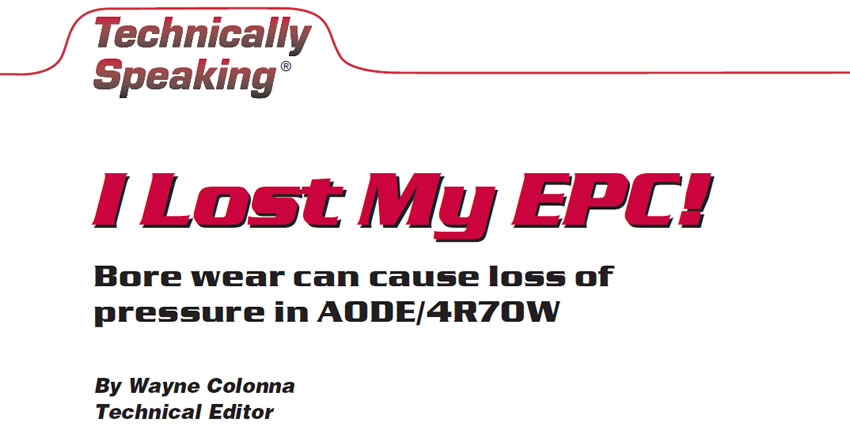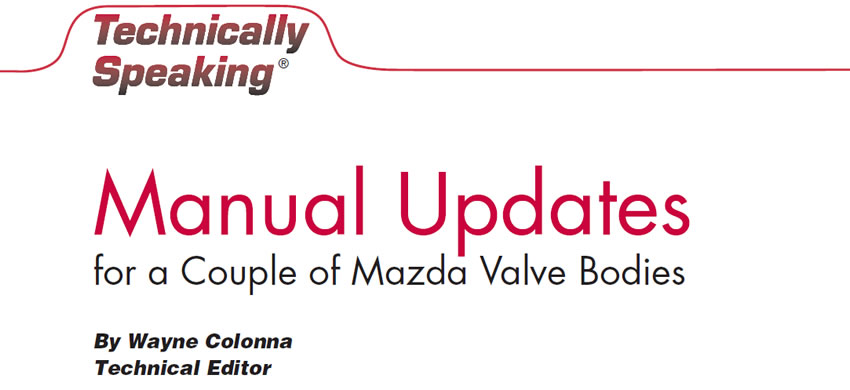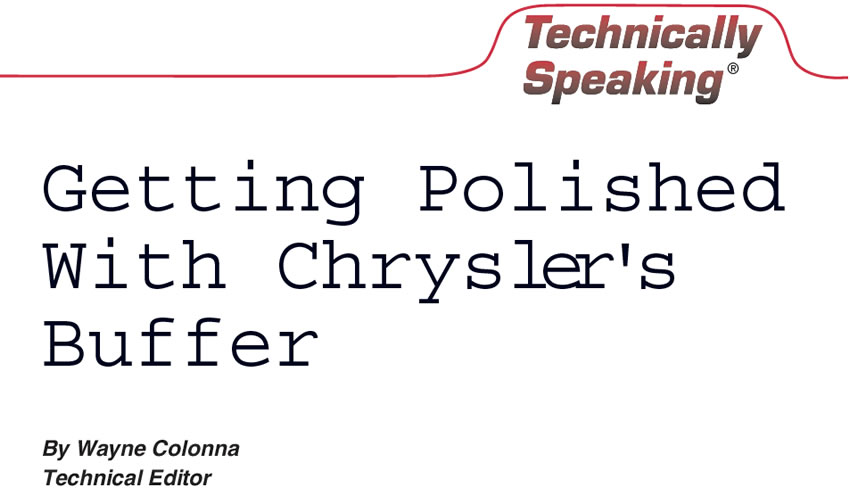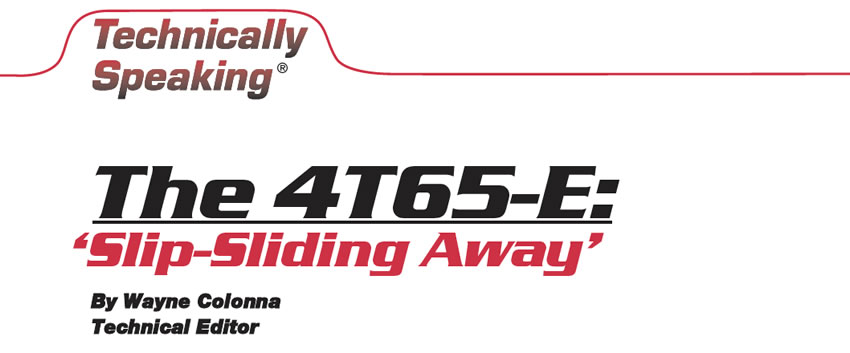I Don’t Like the Cold
The past winter months brought to surface a condition of no upshift from first gear when cold with the SAAB/Volvo 50-42LE transmission. When it warms up, all shift sequences are restored. The time in which this occurs varies.

I Lost My EPC!
The AODE/4R70W transmission has a problem with wear in the pressure-regulator-valve bore that can cause a reduction or complete loss of EPC pressure when the unit is hot. This equates to no or minimal line rise, causing the transmission to have medium- to full-throttle slipping in gear and sliding shifts.
Once a pressure gauge has revealed that EPC pressure remains near 0 at any throttle opening (as well as when the transmission is unplugged), the technician usually replaces the EPC solenoid, yet the problem remains.

Fast, Easy and Simple
It may have taken a while for transfer-case technology to catch up with the technology seen in transmissions, but it has, in fact, arrived and it shows no signs of letting up. The Sport Trac, Control Trac II, Active On-Demand 4WD operation and Progressive On-Demand 4WD operation are examples of the types of computer-controlled transfer cases on the road today.

Simply Complicated
It is in these two vehicles (Tracker and Sidekick) that we find a TCC system distinct from that used in any of the earlier TCC-equipped designs. Figures 1 and 2 show the internal adaptation and description of the components used to control converter-clutch apply. There we see that a TCC solenoid is fitted with some plumbing. The bottom pipe coming from the valve body is band-release pressure, otherwise known as 3rd-gear oil. This ensures that the vehicle will never have TCC until 3rd gear. When the solenoid is energized, this oil is routed through the upper pipe to the pump cover (see figures 3 and 4), where it strokes the converter-clutch control valve into a lockup position.

Manual Updates for a Couple of Mazda Valve Bodies
On occasions technicians may find themselves fighting a loss of line-pressure rise with a GF4A-EL transaxle. The transmission has been unplugged and line pressure still does not rise, verifying that there is, in fact, an internal transmission concern. The pressure-control solenoid has been replaced, the pump and spool valve have been inspected and determined to be in proper working order, and the pan has not been pushed up into the newly installed filter.

A Case of a Leaking Capacitor
It is not uncommon to hear of a technician investigating the inside of a computer as part of a diagnostic routine, especially when dealing with odd continual electrical problems.
Sometimes when the box is opened, a distinct burnt odor confirms the technician’s hunch that it was fried “Fred” causing the problem all along. Sometimes a cracked circuit board is the cause of those pesky intermittent trouble codes. On other occasions the box is filled with water from a leaking sunroof (Honda/Acura) or a leaking heater core (Mitsubishi/Hyundai), or it just had the misfortune of being in a flood.

No Vehicle-Speed Sensor?
A 1995 Lincoln Continental with an AX4N transmission comes into the shop with a gear-ratio-error code. As you are going through the diagnostic routine, you have pretty much determined that the unit needs to come out. But before you remove it, you decide to check for a glitch in the vehicle-speed sensor (VSS).

Getting Polished With Chrysler’s Buffer
The speed buffer in a GM vehicle (see Figure 1) is a familiar piece of hardware for most transmission technicians. And its operation of taking an AC voltage signal from a speed sensor and converting it to a DC pulse signal for the computer is just as familiar. But what does come as a surprise to many is that Chrysler uses a similar speed-signal strategy for many of its passenger cars and vans.

Hot Tech From the Hotline
Have you ever encountered spin-out of the front pump bushing on a Mitsubishi KM unit as shown in Figure 1? Several years ago Paul Yaklin produced a bulletin explaining how the converter pilot bushing would get stuck on the pilot of the converter (see Figure 2). When the converter is removed, the pilot bushing stays with the converter unnoticed. Inevitably, a rebuilt converter then is installed without the adapter bushing in the crank bore. As a result, the centerline of the converter becomes seriously misaligned.

The 4T65-E: ‘Slip-Sliding Away’
Three to six months after you overhaul a 4T65-E transaxle, the vehicle may come back with a code, either P0730 (incorrect/undefined gear ratio) or P1811 (maximum adapt and long shift).
Generally, code P0730 occurs immediately after installation of a transaxle with an incorrect ratio. This could mean that either an exchange unit with an incorrect ratio was installed or incorrect sprockets and/or final drive was used during rebuild in the shop.

Stepless Ratios in CVTs
Continuously variable transaxles use pulleys and a drive belt as the components needed to provide the vehicle with stepless gear ratios. The basic construction of a pulley is movable and stationary surfaces (see Figure 1). The drive belt Honda uses, constructed of about 280 elements held together by two 12-layer steel loops, is manufactured by Van Doorne Transmissie (VDT) of the Netherlands, with Honda giving it a little tweaking of its own (see Figure 2).


